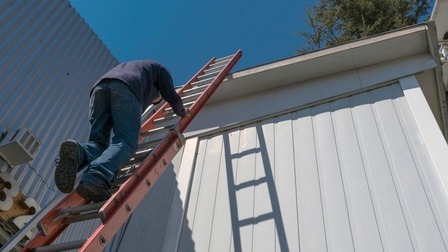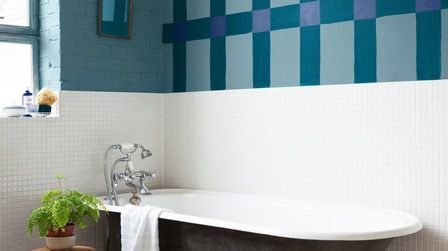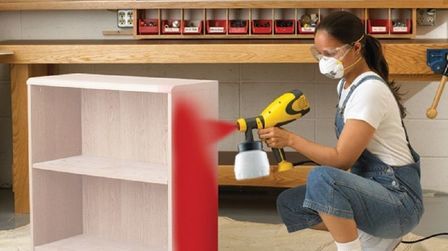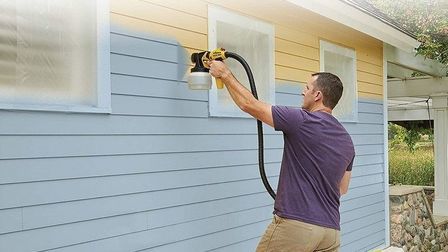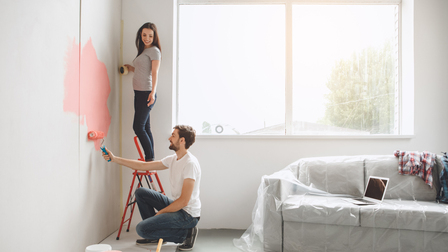Learning how to use an airless paint sprayer gets you started with spray painting. But familiarizing yourself with some ingenious paint spraying tricks lets you achieve a professional painting job in no time.
Tips to Spray Paint Without Making a Mess
The following airless paint spraying tricks will come in handy in your journey to spray painting smooth even coats that stick.
- Always move your body when painting, not just the arm. It helps in ensuring you are spraying parallel to the surface and not in arcs.
- Use continuous movements rather than squeezing the trigger and releasing it while painting individual strips. This helps in achieving even coats.
- When painting surfaces like doors that need to be painted on both sides, temporarily nail wooden 'handles' on the top and bottom edges. They not only help of supporting them in place but also allow you to easily turn them around during the multiple coats application.
- Apply several thin coats rather than a single thick coat. This can be realized by adjusting the pressure pattern such that to give you a very thin coat per paint strip.
- On the thin coats on larger surfaces, spray from top to bottom first. Then, you can apply a 'finish' side-to-side coat. Moving fast can also help in achieving such thin coats.

- If you aren’t in a position to get drop cloths and plastic sheets, cardboards can still work. Lay them down to protect your beautiful floor from the paint mist that will be drifting and falling during the job.
- When painting cabinets, furniture, and doors start from the edges with the sprayer tip closer to them. You can then move to the surfaces.
- The distance from the sprayer to the surface should always the same. That's, maintaining about 25 to 30 centimeters between the two surfaces throughout the process.
- To clear a clogged tip when spraying, twist the tip 180-degrees in reverse direction and point the gun at a drop cloth or scrap of paper. Squeeze the trigger to clear the clogging and rotate back the tip. Always do a test strip spray on a scrap of paper after cleaning the clog.
- When handling small paint jobs like doors, choose a specific location outside your house. Ensure that the place isn't windy or close to your 'special' plants.
- Alternatively, get a spray painting booth or spray shelter when handling small jobs like doors, cabinets, and furniture. The spray tent and shelter stations are easy to assemble and store. They will prevent overspray and allow the paint to ‘safely’ dry. You can station them in your garage or outdoors in one corner of your home.

- To prevent ‘runs’ and spitting, thin your paint by 5 to 15%. If you’re using a handheld paint sprayer, thinning gets easier. By just testing with smaller quantities of the paint in the reservoir until you get the ‘right’ consistency to work with.
Safety Tips When Using an Airless Paint Sprayer
Just as a reminder, always remember to wear protective gear even before you start prepping the paint. The following extra safety tips will help you get the painting job done carefully and effortlessly:
- Always check the surrounding temperature. When it's too hot the paint won't bond, and when it's too cold the paint gun will clog. For spray painting, the ideal temperature is between 45 - 75 degrees.

- Avoid directing the sprayer gun tip on your body or hands. The high pressure from airless sprayers can inject the toxic paints under your skin. In case you puncture your skin accidentally with the spray, you should immediately see a doctor!
- When you stop spraying, keep the trigger locked. Use the pressure relief steps to release the pressure before cleaning and servicing the sprayer. Like when you're unclogging or servicing the tips.
Keep in mind, it's always advisable to consult your paint sprayer user guide since each sprayer is different!
Learn more about different types of paint sprayers here!
Airless Paint Sprayer FAQs
1. Can I Use an Airless Paint Sprayer to Paint Flammable Oil-Based Products?
YES! But be keen to follow all the proper grounding precautions so as to prevent sparks. Acquaint yourself with the necessary directions for grounding metal pails and the sprayer gun.
2. How Do I Avoid Uneven Coverage and Runs?
Using the right tip size and more practice! Just like when using any other equipment, you will need to handle a few test jobs. It helps you in getting to know the right tip for the job and gain some controlling confidence in the process.
3. How to Use a Paint Sprayer Indoors?
Painting interior walls and ceiling uses the techniques shared above on how to use a paint sprayer. Remember to work in a well-ventilated room and wear all the necessary protective gear no matter how small the painting job is.

A paint mist is created when using a paint sprayer indoors. This mist/vapor stays in the room during the entire painting process and drops out of the air after some time. To protect your stuff, mask everything you don't intend to paint.
4. How to Use a Paint Sprayer Outdoors?
Just like spraying indoors, wear protective gear and do some practice test jobs. To get the most out of the steps and tips above, avoid painting when it’s windy, too cold, or too hot.
5. How to Mask a Room for Spray Painting?
When taping off the room, the first step is to consider choosing the right tape. Since different tapes stick on different surfaces, pick the appropriate tape for the surface.
- Remember to wipe down the surfaces you intend to tape off. It helps in ensuring the tape sticks properly. Using a damp cloth works perfectly in wiping away dirt.
- In case you're taping off an entire floor, lay down large sheets of plastic papers and tape off the edges. Alternatively, tape off the edges and use drop cloths to cover the floor.
- Using short strips of tape and overlapping them provide the best masking results. Since long strips of tapes stretch, they end up allowing the paint to bleed onto the surfaces you're covering.
Slowly remove the tape as soon as you're done with the spray painting job. It prevents the tape from sticking and chipping the paint when it's dry. Or even leaving some tape residue.
You can now easily achieve professional-quality airless sprayer painting jobs. With the extra safety tips and spraying tricks, you should be able to use the paint sprayer smoothly and realize your desired results!

